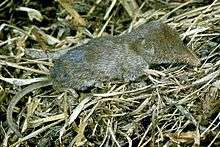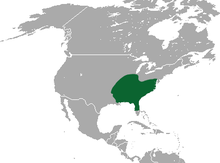Southeastern shrew
The southeastern shrew (Sorex longirostris) is a species of mammal in the family Soricidae. It is found in the southeastern United States.[2]
| Southeastern shrew[1] | |
|---|---|
 | |
| A dismal swamp southeastern shrew, Sorex longirostris fisheri | |
| Scientific classification | |
| Kingdom: | Animalia |
| Phylum: | Chordata |
| Class: | Mammalia |
| Order: | Eulipotyphla |
| Family: | Soricidae |
| Genus: | Sorex |
| Species: | S. longirostris |
| Binomial name | |
| Sorex longirostris Bachman, 1837 | |
 | |
| Southeastern shrew range | |
Description
The southeastern shrew (Sorex longirostris) is reddish-brown above on its back, head area while the shrew is grayish below in the abdomen area. The shrew's long tail is vaguely bi-colored, with dark and light brown as the color. The southeastern shrew is slightly smaller and more reddish than the masked shrew, which looks very similar to the southeastern shrew. Shrews possess lengthy pointed snouts, tiny eyes and ears. Their hearing and smell are very acute. The tips of the incisor teeth are dark chestnut in color. The pigmentation on the tip of their teeth is caused by deposition of iron in the outer pigmented teeth. It weighs in at 0.11-0.14 ounces and has an approximate total length of 2-4 inches. Their lifespan in the wild is rarely more than a year, but they can live as long as 18 or 19 months.[3]
Breeding
The breeding season takes place from March–October and 1 to 2 litters is produced with 1-6 young per litter. The nests are composed of leafy material and fine grasses and are often found in rotting logs.
Behavior
The Southeastern shrew (Sorex Longirostris) are active during the day and night, usually hunting for insects to eat. They make a chipping noise that can be heard occasionally. Southeastern shrews are active, spending most of their time in the burrows of other animals and rooting beneath the leaf litter feeding on the forest floor[4]
Distribution
The habitat for the southeastern shrews include forests & woodlands, scrub, shrub & brushlands, Meadows & fields, Swamps, marshes & bogs. Their habitat ranges from fields to forests, but Southeastern shrews prefer areas in early stages of succession and disturbed areas such as cultivated and abandoned fields with dense ground cover of Lonicera spp. (honeysuckles), grasses, and herbs.[5] Southeastern shrews are active both day and night, spending most of their time in the burrows of other animals and rooting beneath the leaf litter on the forest floor. The shrews have a population density of 12 individuals per acre.[6]
Predator and Prey
Prey: small spiders, small moth caterpillars, small crickets, harvestmen, small beetles and beetle larvae, and centipedes
Predators: snakes, owls, hawks, and carnivorous mammals such as opossums, foxes, bobcats, weasels, and skunks.[7]
References
- Hutterer, R. (2005). Wilson, D.E.; Reeder, D.M. (eds.). Mammal Species of the World: A Taxonomic and Geographic Reference (3rd ed.). Johns Hopkins University Press. pp. 290–291. ISBN 978-0-8018-8221-0. OCLC 62265494.
- Hammerson, G. (2008). "Sorex longirostris". IUCN Red List of Threatened Species. 2008. Retrieved 8 February 2010.CS1 maint: ref=harv (link)
- "Sorex longirostris Bachman; Southeastern Shrew". pick4.pick.uga.edu. Retrieved 2017-03-30.
- "Tennessee Watchable Wildlife | Southeastern Shrew". www.tnwatchablewildlife.org. Retrieved 2017-03-30.
- Linzey, Donald W. (2016). "Mammals of Great Smoky Mountains National Park: 2016 Revision". Southeastern Naturalist. 15: 1–93. doi:10.1656/058.015.m801.
- Anonymous (2014-07-16). "Southeastern Shrew". Outdoor Alabama. Retrieved 2017-03-30.
- "Dismal Swamp southeastern shrew | VDGIF". www.dgif.virginia.gov. Retrieved 2017-03-30.
